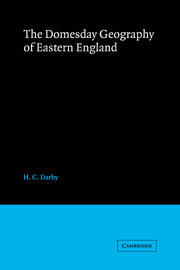Book contents
- Frontmatter
- Contents
- Preface
- NOTE TO THIRD EDITION
- List of Maps
- Chapter I THE DOMESDAY BOOK
- Chapter II LINCOLNSHIRE
- Chapter III NORFOLK
- Chapter IV SUFFOLK
- Chapter V ESSEX
- Chapter VI CAMBRIDGESHIRE
- Chapter VII HUNTINGDONSHIRE
- Chapter VIII THE EASTERN COUNTIES
- Appendix I Summary of Domesday Book for the Eastern Counties
- Appendix II Extension and Translation of Frontispiece
- Index
Chapter VIII - THE EASTERN COUNTIES
Published online by Cambridge University Press: 05 November 2011
- Frontmatter
- Contents
- Preface
- NOTE TO THIRD EDITION
- List of Maps
- Chapter I THE DOMESDAY BOOK
- Chapter II LINCOLNSHIRE
- Chapter III NORFOLK
- Chapter IV SUFFOLK
- Chapter V ESSEX
- Chapter VI CAMBRIDGESHIRE
- Chapter VII HUNTINGDONSHIRE
- Chapter VIII THE EASTERN COUNTIES
- Appendix I Summary of Domesday Book for the Eastern Counties
- Appendix II Extension and Translation of Frontispiece
- Index
Summary
The Domesday information for a county gains greatly in interest when set against that of neighbouring counties. There are many differences in phraseology between individual counties and between groups of counties. Some of these differences arose from varying economic and social conditions. Others may reflect nothing more than the ideas and language of different sets of Commissioners. One of the most obvious differences lies in the method of assessment. Some counties were assessed in terms of hides and virgates or of hides and acres; others in terms of carucates and bovates; others in yet different ways. Nor are the differences between county and county confined to the method of assessment. The statement about plough-lands appears on the surface to be solid and satisfactory, but the significance of the information may not always be the same; the form of the entry varies, and, besides, there seems to be a strong conventional element about some of the statistics. Where the number of ploughlands exceeds that of plough-teams, the entries for some counties draw attention to the fact, and state that so many teams could be added or restored; but such explicit declaration is far from general. For a number of counties there is even no statement about plough-lands, and we are left to infer their number from the information given about the teams themselves. The information about population is equally varied. In some counties there were many freemen and sokemen; in others, they were rare or completely absent.
- Type
- Chapter
- Information
- The Domesday Geography of Eastern England , pp. 350 - 372Publisher: Cambridge University PressPrint publication year: 1972

